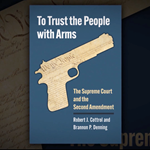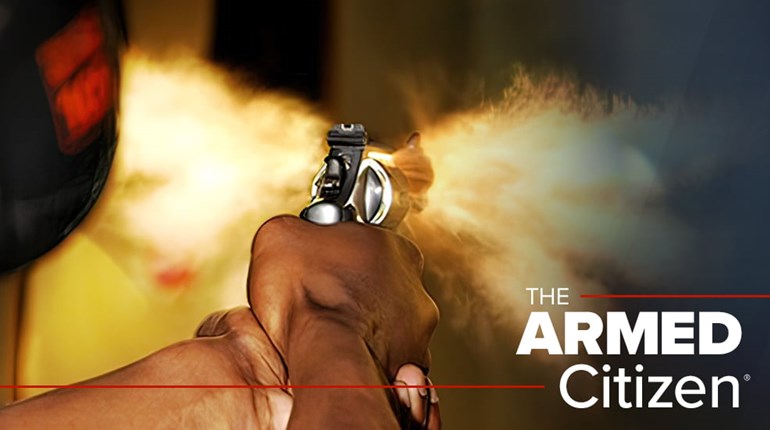
This feature appears in the February ‘16 issue of NRA America’s 1st Freedom, one of the official journals of the National Rifle Association.
The AR-pattern rifle is proving to be something of a dreadnaught in the firearm industry, and with good reason. Now reliable, versatile and often very accurate, it’s occasionally hard to recollect how many decades of doubt stalked the platform.Every aspect of the big-bore Colt exudes strength and thorough modernity.
Metaphorically at least, it’s easy to start a fistfight by racing too quickly to the defense of the AR or—in updated parlance—the Modern Sporting Rifle. Inevitably taking some lumps in any such jaw is venerable Colt’s Manufacturing, being there, as Colt was, at the very start. But if that company’s LE901-16s Modular Carbine is any example, a host of those erstwhile critics should shortly fall silent. Otherwise, a few lumps of their own might soon be rising by way of 16th President Abraham Lincoln’s warning: “Better to remain silent and be thought a fool, than to speak and remove all doubt.”
Chambered as Eugene Stoner’s (and Bob Fremont’s and Jim Sullivan’s) mid-’50s Armalite prototypes were—in 7.62x51/.308 Winchester—the LE901 reinstates the original ammunition power level envisioned for the AR-10. But other than a very rough external resemblance and operating principles, that is where the similarities end.
Every aspect of the big-bore Colt exudes strength and thorough modernity. Polymer furniture at stock and grip (Vltor IMOD collapsible and vanilla A2, respectively) are familiar, and beefier proportions at key structural points are certainly sequitur. The net result is apparent on an initial heft of the rifle: The more familiar 5.56/.223 AR runs about 7 pounds sans optics, but the Modular Carbine is closer to 9.5.
That “modular” nomenclature of the Colt has something to do with the weight difference, and the particulars are no less impressive for being straightforward: Extra forged aluminum in the area of the magwell and pivot pin allow for the use of an “Adapter Block Conversion Kit.” The kit makes the LE901 lower capable of accepting any mil-spec 5.56 upper. A roughly “U”-shaped fitting cleverly uses the downward displacement of the 7.62 pivot pin hole to lock itself in place, while simultaneously providing a conventional pivot hole location and gobbling up the extra magwell volume. Colt claims a practiced hand can install the block in under a minute, and we’re inclined to agree.
As a result, 5.56 mags will now fit the 7.62 lower and allow it to do double caliber duty while stock fit, hand/grip position and the other (excellent, ambidextrous) controls remain exactly where you expect. That’s a neat, useful trick—hence the term “modular.” It’s also nice to be able to run 30-cents-a-stick 5.56 to keep your hand in as opposed to 70-cent 7.62.
Keep in mind we aren’t suggesting a 5.56 upper as any sort of necessity, as the supplied 7.62 upper of the Modular Carbine is something special in its own right. On most ARs, the major components of a “complete” upper include the bolt and bolt carrier, barrel, drive system (gas, like our Colt, or piston-driven), a handguard, and the upper receiver itself, to which all the other components attach or are inserted. The Colt importantly joins the last two in a single piece, resulting in what’s known as a “monolithic” upper.
While such a monolith (literally meaning “one stone”) isn’t unique to the LE901, it is somewhat rare. Its several advantages stem from those united components: Such a single piece is more precisely barrel-aligned and, more importantly, creates an uninterrupted platform for sights. This takes misalignment out of the mounting and sight-in picture (the correction of which can consume limited elevation and windage adjustments in both optic and iron/backup sight systems in a hurry). Utterly stripped of any mounting issues, our range time with the LE901 became a straightforward pleasure.
“Bridging” the receiver/handguard rail junction for some longish tube optics appropriate for 7.62/.308 is also avoided, and with it the many problems associated with putting torque on a tube optic. Cosmetic damage to the scope body is the most obvious of these, but also the least serious. Cantilever-style scope mounts can eliminate such issues nowadays, but their added weight over more conventional rings is unnecessary with a monolithic upper.
Utterly stripped of any mounting issues, our range time with the LE901 became a straightforward pleasure. Moderate recoil of the 7.62, especially in a rifle as stout as the Colt, means it can be an all-day pleasure, too. It’s also marvelously versatile: perfectly capable at non-trivial distances with heavier bullets, but admirably flat-shooting with bullets in the very useful 130- to 150-grain weight class (point blank ranges well beyond 300 yards, for instance, depending on bullet choice).
We started with the supplied fold-down backup/iron sights, and immediately had good results. Two-inch groups were easy to produce with the Colt-labeled Troy rear and gas-block mounted front. (A nifty unit: We especially liked the forward-facing lock.)
A non-magnifying EOTech EXPS3 was next. We didn’t improve noticeably on accuracy, but speed was clearly much better. (We remind again about using this technology if you have corrected vision: Use your distance prescription to get a clear unmagnified reticle image.) Adding a G33.STS 3x magnifier did result in a noticeable accuracy improvement, with groups hovering just over an inch when we did our part. We hear gripes about this combination on grounds of the weight it adds to any rifle, but it remains a favorite for easy mounting and adjustment, and for shooting way better at distance than 3x has any right to do.
Keeping in mind that 7.62/.308 is an extremely credible performer to 500 yards and beyond, our last optic added some more serious magnification—a personal Steiner 4-16x50 (now replaced by the GSC 4-20x50). Naturally, we tightened the last mounting screw as weather karma chomped down hard (grrrrrrr and brrrrrrr!). But it didn’t keep us from using those last two boxes of Federal Premium “Gold Medal” Match 168s to see what some careful trigger work and the free-floated barrel could accomplish at 100 yards, albeit indoors.
A mere five characters will suffice: .385”.
In a session where we had a terrible case of the “twos,” (a pair of very good shots—for us, at least: .231”, .221”, .181”—interspersed with a lousy third in no particular order), we nevertheless produced a three-shot group of those paltry dimensions. Here, we take our only crack at the LE901: It’s simply too good a rifle to leave the stock “military” trigger in, and we think half-minute outings would be commonplace with better lockwork. As AR fans know, such an upgrade verges on trivial in this day and age.
A final thought on this scion of Hartford: Even if you’re new to the whole AR thing, consider just how many hunting and shooting challenges the LE901 will meet, and perhaps conquer, with ease. Thoughtful execution combines with a versatile, accurate, widely available native caliber to give authentic “legs” to this modern carbine. Wherever you take one, we suspect it won’t be easily outpaced.
As to doubts, new or old, this Colt thoroughly stampeded all of ours.
Nuts And Bolts
The details we generally reserve for our nuts and bolts discussion are few in number: The Modular Carbine is unusually complete. From the inclusion of a couple of quick-release sling swivels to accommodate field use, to the Vortex flash-hider which terminates the 1-in-12 twist barrel, we think it’s an extremely good rifle that will outperform many alternatives and give years of satisfying service. From the inclusion of a couple of quick-release sling swivels to accommodate field use, to the Vortex flash-hider which terminates the 1-in-12 twist barrel, we think it’s an extremely good rifle that will outperform many alternatives...
To this assessment, we’d add an observation and a caution.
The first we’ve partially noted—a plain vanilla military trigger. While it was good enough to produce many superbly precise shots in our middling-skilled hands, we fitted two alternatives to test a Colt claim. A cartridge-style CMC flat-face trigger assembly went in with almost laughable ease, and a superb conventional Jard wasn’t much tougher. Both drew a positively Pavlovian reflex to get back to the range: We’ll hope to have an update online before the rifle goes back. But the upshot is simple: Colt made sure entirely conventional upgrades would drop right into the rifle—well done!
The caution relates to that 1-in-12 twist rate barrel. Reading earlier reviews (yes, we do) of the LE901, they contained some—well, disappointing?—shooting results, and particularly for a rifle in this price class. We observed that many of these ho-hum performances were achieved with the current darling of 7.62/.308 accuracy: 175-grain BTHP or OTM match bullets. We had a suspicion about this, and—lo and behold—were able to reproduce the not-quite MOA spreads they found common.
While we’d leave diagnosis to riflesmiths and ballisticians, a quick trip out to a Twist Rate Stability Calculator (like bergerbullets.com/twist-rate-calculator/) readily shows a possible reason for the phenomenon: 168-grain BTHPs, which produced our good results, are fully stabilized by the Colt barrel, while the 175s are not. It’s a caution worth noting anytime a firearm fails to perform as expected, and an even better way to avoid ammunition or component selection miscues.
Finger-wagging Colt for that barrel choice isn’t much of a plan, either: 1-in-12 twist barrels have their own set of benefits relative to quicker twists, and have produced marvelous 7.62/.308 groups for decades.
MSRP for the Colt LE901-16s is $1,999. Visit Colt at colt.com.


































